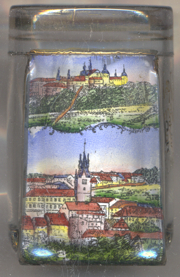

|
| ČESKÁ REPUBLIKA | CZECH REPUBLIC |
| Středočeský kraj | Central Bohemia region |
| Okres: Příbram |
 Příbram (formerly in German Pribram or Freiberg in Böhmen)
is situated at an elevation of 502 m on the Litavka river in the foothills of the Brdy range,
about 60 km southwest of Prague. With a population of about 32,900 (2017) it is the
third-largest in the Central Bohemian region (after Kladno and Mladá Boleslav). It is also
the administrative centre of the district of the same name.
Příbram (formerly in German Pribram or Freiberg in Böhmen)
is situated at an elevation of 502 m on the Litavka river in the foothills of the Brdy range,
about 60 km southwest of Prague. With a population of about 32,900 (2017) it is the
third-largest in the Central Bohemian region (after Kladno and Mladá Boleslav). It is also
the administrative centre of the district of the same name.
The earliest written document mentioning Příbram dates from 1215 and mentions it as a property of the bishops of Prague. Příbram castle was built under Prague archbishop Arnošt of Pardubice. During Hussite wars in the 15th century, Příbram stood on the reformation side, but was captured and pillaged four times by Catholic aristocracy. Its privileges were confirmed in 1463 and in 1496 it obtained the status of a town when it came in possession of the Bohemian Crown. In 1579, Příbram was made a Royal Mining Town. Since the 17th century the mining boom was followed with the city growth. Five major deep-mines were built in the 18th century. The Příbram mining district became one of the most modern in Europe in the 19th century up until about the 1920s. During the Nazi occupation between 1939 and 1945, the town was renamed Pibrans. the neighbouring town of Březové Hory (Birkenberg) was merged with Příbram in 1953.

The Gothic  church of St. James the Greater (kostel sv. Jakuba Stařího)
[near left, no. 3316: bottom picture, centre] was founded in the 1st half of the 13th century. The
Neo-Gothic tower was added in the 19th century.
church of St. James the Greater (kostel sv. Jakuba Stařího)
[near left, no. 3316: bottom picture, centre] was founded in the 1st half of the 13th century. The
Neo-Gothic tower was added in the 19th century.
The important pilgrimage site  Svatá
Hora [near left, no. 3316: top picture] is located just above the city.
Svatá
Hora [near left, no. 3316: top picture] is located just above the city.
[https://en.wikipedia.org/wiki/Příbram, https://de.wikipedia.org/wiki/Příbram,
https://cs.wikipedia.org/wiki/Příbram]
![[scale]](lineal.jpg)